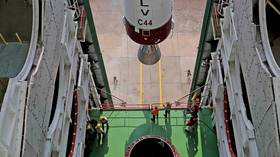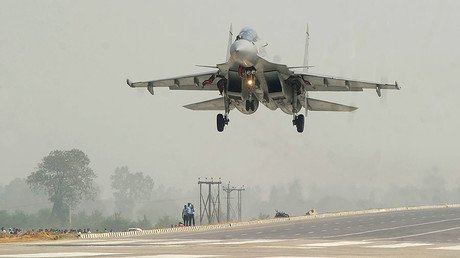Russia, India discuss ‘futuristic’ tech & space cooperation ahead of New Delhi’s lunar mission

Ahead of India’s first-ever lunar lander launch this weekend, Russia has offered New Delhi a hand in space exploration, with a range of cooperation opportunities, including the delivery of an Indian astronaut to space in 2022.
Potential joint development of “futuristic technologies,” including rocket engines and propellants, as well as new space launch systems and spacecraft, took center stage in the discussion this week when the head of Russian space agency Roscosmos, Dmitry Rogozin, met with the Indian National Security Advisor, Ajit Doval, in New Delhi.
On July 11, a #Russian delegation led by Dr Dmitry #Rogozin (@Rogozin), DG of State Space Corporation @roscosmos, had a meeting with Mr Ajit #Doval, National Security Advisor, Government of #India, as well as the top management of the @isro.@mfa_russia@MEAIndia@IndEmbMoscowpic.twitter.com/zXTVPxHgg7
— Russia in India (@RusEmbIndia) July 11, 2019
Moscow also welcomed future Indian participation in the International Space Station program, and promised assistance to complete the country's Human Space Flight Program – 'Gaganyaan' – aimed at sending an Indian citizen into space during the nation's 75th independence anniversary in 2022, the Ministry of External Affairs added.
Also on rt.com India to launch first-ever moon lander to study strange ‘large excess of mass’ (PHOTOS)Russia and India have a 40 year history of cooperation in space exploration. One of the key milestones of that collaboration saw the first Indian astronaut, Rakesh Sharma, travel to space in 1984 aboard the Soyuz T-11 spacecraft.
“Today there is new respect for India's rapidly growing capabilities in outer space, and Russia sees India as a key partner for promoting peaceful uses of outer space,” a source familiar with the discussion, told local news outlets on Friday.
This Sunday, New Delhi is looking to repeat Russia's historic 1969 'Lunokhod 1' landing by launching its ‘Pragyaan’ rover into space to the Moon.
On this edition of #RocketScience, P Sreekumar — Director of SSPO — helps us understand why we are going back to the Moon, and how Chandrayaan 2 serves to identify the presence of water below the lunar surface - https://t.co/YuN5SkyPZa#Chandrayaan2#GSLVmkIII#ISROpic.twitter.com/rhItflbJXU
— ISRO (@isro) July 12, 2019
If you like this story, share it with a friend!














